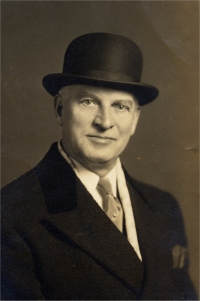|
Euclid Golf represents the work of Barton R. Deming, a real estate developer
who brought together
Cleveland’s
leading architects and builders to create one of the finest, planned
residential communities in the country. Barton Roy Deming was born in
Windsor, Canada, August 21, 1875. His father, Hubert V. Deming, was
originally from
Watertown,
New York,
and had settled in Canada where he became involved in the mercantile and
lumber business.
Barton was the ninth of ten children. He was educated in Sarnia,
Canada and graduated from its high school in 1892. In 1893 he followed
several of his brothers to
Cleveland,
Ohio.

Barton R. Deming
(undated photo)
In
Cleveland, Deming first worked in the ordering department for the Mechanical
Rubber Company and then as a bookkeeper for the Oglebay, Norton & Company.
After spending two years in the West to improve his health, he rejoined his
brothers in Cleveland and assisted them in organizing The Deming Brothers
Company in 1903.
Hubert V. Deming, Jr., the oldest brother, was president of the firm until
1908 when Barton took over. Grant W. Deming was the vice-president and
manager, and Orville G. Deming was secretary. Barton R. Deming was
treasurer. Cecil C. Deming, the youngest brother, was also involved.
The
Demings soon made a name for themselves in real estate. They developed
several high-quality allotments in
East Cleveland
such as the Grantwood Allotment (Grantwood,
Pasadena,
Drexel, Tacoma, and Massie Avenues) and the Columbia Allotment (Columbia,
Empire and Kempton Avenues).
According to Cleveland historian, Samuel Orth, who wrote in 1910: “the
real-estate operations of the firm have constituted an important chapter in
the history of Cleveland for the past six years, the development, upbuilding
and adornment of the city being largely promoted through their efforts.
They have opened up many of the finest additions in Cleveland and have
erected residence property of the highest grade.”
In
1905, Grant Deming organized the Deming Realty Company. This company
developed the Hyde Park Allotment beginning in 1905 in Cleveland Heights.
In 1909 Grant’s Heights Realty, Cleveland Heights Realty and Boulevard Land
& Building Company developed the (first) Forest Hill Allotment on land previously
owned by John D. Rockefeller (roughly bounded by Euclid Heights to the
North, Coventry Road to the West, Lee Road and Superior Street to the East,
and Cedar Road to the South), also in Cleveland Heights.
Barton R. Deming was not involved in the later real estate activities of his
brother Grant. A June 1, 1913, Cleveland Leader advertisement for the
Euclid Golf Allotment carries this “important” announcement: “B.R. Deming,
who heads the B.R. Deming Company, developers of Euclid Golf Allotment,
never has been connected in any way with Forest Hill, or other Heights
property before the opening of this allotment. This enterprise has no
connection with any other Heights allotment.”
The
reason for this announcement is unclear. Perhaps Barton Deming
believed he needed to state this fact in order to secure his deal with
Rockefeller or perhaps he just wanted to differentiate himself from his
brother. Mr. Clarence E. Terrill, Manager of Rockefeller's Abeyton Realty
Company, stated in
a letter dated February 5, 1913, “Mr. [Barton] Deming would surely be a splendid chap
to take hold of [the Euclid Golf property], while his brother Grant Deming
is somewhat discredited, Mr. B. R. Deming stands high and has no connection
in a business way with his brother Grant.”
Grant Deming may have fallen into disfavor with Rockefeller when he fell
behind on mortgage payments for the original Forest Hill Allotment.
Nevertheless, Grant Deming did successfully meet his financial obligations
and went on to develop many other properties in the Heights. Later
Euclid Golf advertisements make no more mention of the issue.
Barton R. Deming lived at
2485 Fairmount Boulevard,
in Euclid Golf, from 1914 until the death of his wife, Helen, in March of
1934 and the marriage of his only daughter, Elaine Allen, to Weston Schmitt
the same year. His nephew, Grant Deming, Jr., helped him auction off
his furnishings and then lived with him in the Heights Rockefeller Building
apartments on Mayfield Road and Lee Road in Cleveland Heights (National
Register of Historic Places, 1986).
Deming worked for John D. Rockefeller, Jr. on the development of his
father’s Forest Hill estate into a residential village (Forest Hill is
located in Cleveland Heights and East Cleveland; National Register Historic
District, 1986).
When Cleveland Heights established a Zoning Commission in 1920, Barton R.
Deming was one of its first appointed members.
Towards
the end of his life, Deming lived with his sister, Millie, at 3565 Stoer
Road, in Shaker Heights. He served for many years as a trustee of the
Cleveland Real Estate Board, and later established the Deming Ironing
Company, which manufactured gas electric ironing machines. He died at
Overlook House, a Christian Science Home located in
Cleveland Heights,
on September 15, 1956, at the age of eighty-one.
|